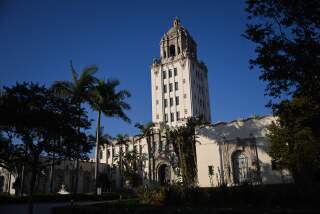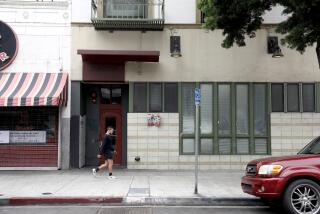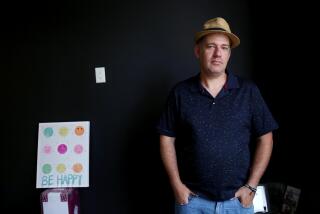Official’s Alleged Conflicts Are Probed : Ethics: County building official conducted private business with developers whose projects he approved, records show. He denies any wrongdoing.
- Share via
A senior Los Angeles County building official has transacted private business with developers whose projects he approved and has issued permits for two of his own developments, records show.
Grant Lawseth, the second in command at the county’s Calabasas building office, is under investigation by the Los Angeles County auditor/controller’s office for alleged conflicts of interest spanning 20 years, The Times has learned.
The auditor’s office confirmed its investigation but declined to release details.
“I cannot discuss the investigation because it is not complete,” said Marion Romeis, head of the auditor/controller’s special investigations unit.
According to testimony he gave this year in a civil deposition, Lawseth had a deal with one developer to share equally in the profits of a half-million-dollar land acquisition for which Lawseth put up less than 20% of the down payment.
Records show that Lawseth approved permits for four houses the developer built in the Santa Monica Mountains, one while they were co-owners of the property in 1988.
In another case, Lawseth in 1991 issued a grading permit to a builder nine months after selling him a piece of vacant land for $117,000 more than Lawseth had paid for it 10 months earlier.
State conflict-of-interest law requires public officials to disqualify themselves from participating in actions affecting anyone with whom they share a financial interest, including joint ownership of real estate.
However, Jeanette Turvill, a spokeswoman for the Fair Political Practices Commission, which enforces the conflict law, said decisions requiring no official discretion--those that are simply “ministerial, secretarial, manual or clerical”--are not subject to enforcement. She added that the agency has never been asked to decide whether actions of a building inspector would be covered under the statute.
In an interview, Lawseth denied any wrongdoing. He contended that none of his decisions involving his own properties or those of his business associates fall under conflict-of-interest rules because the official actions he took were merely clerical; he did not exercise discretion in making them, he said.
He said any allegations against him are based on “misinterpretation” of the public documents.
Lawseth’s deposition was taken earlier this year as part of one of two federal lawsuits pending against Lawseth and his employer, the county Division of Building and Safety, and others. Citing the litigation, division officials declined to comment.
In one of the lawsuits, Arthur Starz and Kathleen Kenny of Topanga alleged that Lawseth and other county officials withheld building permits for one of three houses they constructed in Topanga because they would not pay bribes. They say Lawseth told Starz he would “work out all of the problems” if Starz would “get inside the system.” They alleged that a county health inspector urged Starz to pay Lawseth $25 for a “cheap permit,” and they did not realize “until later that $25 was a euphemism for $25,000.”
In the other case, Andy and Susan Huber alleged that they obtained a building permit through the county’s Calabasas building office, but that Lawseth then issued an order to stop their grading. They said Lawseth promised them they could resume work if they would sign an agreement to maintain a road, but they were later denied a new permit. They said they then gave up the project because they concluded that they would not be allowed to proceed without making payoffs. They have alleged in court that they were the victims of extortion.
The lawsuits further alleged that Lawseth quickly approves the projects of applicants who are friendly with him and even goes out of his way to help them. Both cases are awaiting trial this year in U.S. District Court. Lawseth has filed a defamation lawsuit against Kenny and Starz.
Citing the pending litigation, Lawseth declined to discuss details of his real estate activities in an interview.
*
As an inspector in Malibu from the mid-1960s to 1991, Lawseth issued building and grading permits. For several years, he was office manager, responsible for all such permits. When the office closed after Malibu incorporated, he became assistant office manager of the Calabasas office.
In 1988, Lawseth and his wife bought two adjoining vacant lots in a Thousand Oaks subdivision called North Ranch for $1.1 million.
In his deposition, Lawseth said he put $56,000 down on one of the lots and solicited Culver City-based contractor Gerald L. Williams as a co-investor. Williams, he said, put up $300,000 and they borrowed the rest of the $560,000 purchase price for one lot. They agreed to share equally in the profits, Lawseth testified.
Lawseth testified that he knew Williams because he had inspected a house Williams was building.
Williams did not respond to several requests for an interview. While he owned land with Williams, Lawseth issued electrical and sewer permits for a house that Williams’ firm, Williams Construction, was building at 140 S. Valle Lindo Lane, north of Malibu, and he later inspected the construction, giving it final approval nine months after Williams sold his interest in the land, according to county building records.
Property records show that Lawseth and his wife bought the second North Ranch lot and held it for 10 months before selling it for $117,000 more than they paid for it to Dominic Ricciardone, a Santa Monica Mountains real estate investor. Ricciardone said he did not know Lawseth before he bought the land, on which he hoped to build a house for himself.
Building records on file in Malibu show that within a year after the sale, Lawseth issued several permits to Ricciardone. Two allowed Ricciardone to install a pump and do grading on a piece of vacant land on Pacific Coast Highway in Malibu that he was planning to develop.
*
Lawseth approved a third permit allowing Ricciardone to excavate dirt to enlarge the yard of his Malibu home, in spite of the fact that the property was in the California Coastal Zone and county employees are responsible for ensuring that applicants have the necessary coastal permits before allowing work to begin. The California Coastal Commission later ordered the work stopped and denied Ricciardone’s application for a permit to resume grading because it would cause environmental damage.
Lawseth wrote a letter to the commission saying he approved the grading after Ricciardone and his civil engineer “called me for a field meeting” and urged approval of the application, arguing that the grading “enhanced the erosion protection of the natural slopes.”
Permits on file at the Calabasas office also show that in 1976, Lawseth approved building projects for himself and his future wife on two lots in Latigo Canyon above Malibu.
Lawseth’s signature appears on a permit allowing Wendy Adams, who now is married to Lawseth, to build on one of two lots she had acquired.
Lawseth also signed the building permit for the adjacent lot, which he bought for $5,900 in an estate sale. Although the permit identified the applicant as George Berzsenyi, title records show that Lawseth was the legal owner of the land. In his deposition, Lawseth identified Berzsenyi as Adams’ brother.
Both permits were issued eight days before an expansion of the California Coastal Zone into the mountains went into effect Jan. 1, 1977. By beating the deadline, the couple were able to build without the expense and risk of submitting the proposal to the Coastal Commission.
Property records show that Lawseth and Adams sold their developments for more than they paid. Lawseth had a modular house built on his lot at an estimated cost of $30,000, and sold it for more than $145,000 four years later. Adams built a house on her lot and sold it for $245,000 in 1985.
*
Lawseth, in an interview, said that in compliance with state conflict-of-interest laws, he disclosed his role in both the 1976 projects to his supervisor, who approved. Lawseth said the Building and Safety Division superintendent, Tom Remelard, would have records of the disclosure. In an interview, Remelard said the division’s records are purged every five years. He said, however, that a county policy prohibits building officials from issuing permits for any property in which they have an interest.
Compared to Los Angeles County, which requires Lawseth to report business--but not real estate--interests under a general conflict-of-interest policy covering all its employees, the city of Los Angeles has stringent rules specifically aimed at building officials.
Nicolino delli Quadri, spokesman for the Los Angeles City Building and Safety Department, said his agency views the potential for undue influence in the inspection process so seriously that it rotates inspectors from one district to another so they won’t grow too close to contractors.
“Definitely it does fall under the conflict-of-interest codes,” delli Quadri said of building inspectors’ actions. “I would say what he or she does is discretionary as to whether a particular construction element passes inspection or meets his approval.”
More to Read
Sign up for Essential California
The most important California stories and recommendations in your inbox every morning.
You may occasionally receive promotional content from the Los Angeles Times.







